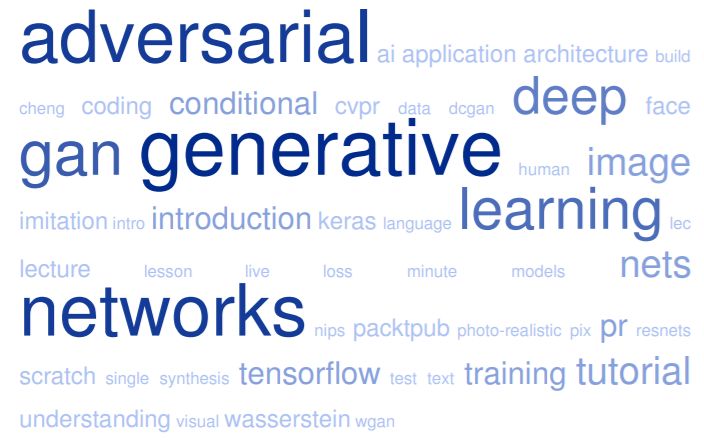
Notes:
A generative adversarial network (GAN) is a type of machine learning model that consists of two parts: a generator and a discriminator. The generator is trained to produce synthetic data that is similar to a given training dataset, while the discriminator is trained to distinguish between real and synthetic data. The two parts of the model are trained simultaneously, with the generator trying to produce data that is realistic enough to fool the discriminator, and the discriminator trying to accurately identify the synthetic data. This adversarial training process can help the generator learn to produce high-quality, realistic synthetic data.
In the context of dialog systems, GANs can be used to generate natural language responses that are similar to those in the training data. For example, a GAN might be trained on a large dataset of conversational exchanges, and then be used to generate responses to new inputs from the user. This can help the dialog system generate more diverse and natural responses, and make the conversation more engaging and realistic. GANs can also be used in other parts of a dialog system, such as for text generation or text summarization. Overall, GANs are a promising approach for natural language generation, and have the potential to improve the performance and user experience of dialog systems.
Wikipedia:
See also:
100 Best Deep Learning Tutorial Videos | 100 Best GitHub: Deep Learning | 100 Best Natural Language Deep Learning Videos | 100 Best TensorFlow Tutorial Videos | Deepfake News 2019 | Skipgrams, Deep Learning & Question Answering 2017 | TensorFlow & Chatbots 2017
- Deep Learning 34: (1) Wasserstein Generative Adversarial Network (WGAN): Introduction
- Generative Adversarial Network (GANs) Full Coding Example Tutorial in Tensorflow 2.0!
- Deep Learning 27: (1) Generative Adversarial Network (GAN): Introduction and Back-Propagation
- Generative Adversarial Networks (GANs)- Intro & Example in Keras
- Introduction to Generative Adversarial Networks
- Generative Adversarial Networks tutorial Part 1
- Generative Adversarial Networks tutorial Part 2
- What are Generative Adversarial Networks (GANs) and how do they work?
- CVPR18: Tutorial: Part 4: Generative Adversarial Networks
- CVPR18: Tutorial: Part 3: Generative Adversarial Networks
- CVPR18: Tutorial: Part 2: Generative Adversarial Networks
- CVPR18: Tutorial: Part 1: Generative Adversarial Networks
- Generative Adversarial Networks (GANs) – How and Why They Work
- Introduction to Building Generative Adversarial Networks (GANs)
- Tensorflow: Generative Adversarial Network(GAN) Demonstration
- Intro to Generative Adversarial Networks (GANs)
- Generative Adversarial Networks (GAN): 1D demo
- Generative Adversarial Networks: how do they work?
- Learning Generative Adversarial Networks: Introduction to Conditional GAN| packtpub.com
- Learning Generative Adversarial Networks: Introduction to StackGAN| packtpub.com
- Generative Adversarial Networks Tutorial
- Ian Goodfellow: Generative Adversarial Networks (NIPS 2016 tutorial)
- Advanced Deep Learning with Keras: An Intro to Generative Adversarial Networks|packtpub.com
- GAN Lecture 1 (2017): Introduction of Generative Adversarial Network (GAN)
- Tutorial on Generative adversarial networks – GANs as Learned Loss Functions
- Tutorial on Generative adversarial networks – Connections between adversarial training and RL
- Tutorial on Generative adversarial networks – Do GANs learn the distribution?
- Tutorial on Generative adversarial networks – Visual Synthesis and Manipulation with GANs
- Tutorial on Generative adversarial networks – Domain Adversarial Learning
- Tutorial on Generative adversarial networks – Live demo session2: iGAN / pix2pix / CycleGAN
- Tutorial on Generative adversarial networks – Evaluating Generative Models
- Tutorial on Generative adversarial networks – GANs in the Wild
- Tutorial on Generative adversarial networks – Conditional GANs, StackGAN
- Tutorial on Generative adversarial networks – Autoencoder GANs
- Tutorial on Generative adversarial networks – Introduction
- Tutorial on Generative adversarial networks – Live demo session: iGAN / pix2pix / CycleGAN
- Introduction to Generative Adversarial Networks (GAN) with Apache MXNet – AWS Online Tech Talks
- Tutorial : Theory and Application of Generative Adversarial Network
- Generative Adversarial Networks Tutorial – How do GANs work?
- GAN (Generative Adversarial Network) Demonstration
- DALI 2017 – Workshop – Theory of Generative Adversarial Networks – Introduction
- Generative Adversarial Network visualization how it learns to draw a Number from MNIST